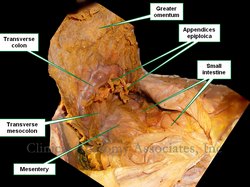The [greater omentum] is a large, fatty apron-like structure that covers the abdominal viscera inferior to the greater curvature of the stomach. It is formed by a double peritoneal layer that contains fat, vessels, lymphatics, and nerves. This double peritoneal structure is continuous with the anterior and posterior serosal layers of the greater curvature of the stomach, drapes inferiorly, sometimes all the way to the pelvis and the folds upon itself posteriorly and superiorly ascending to become continuous with the anterior and posterior serosal layer of the transverse colon. Because it folds upon itself, the greater omentum can be considered to be a four-layered structure. See accompanying image.
The greater omentum contains vessels that arise from the right and left gastroepiploic arteries and veins as well as omental (epiploic) branches of the greater curvature vascular arcade.
The left border of the greater omentum reaches to the splenic hilum, while the right border extends as far as the pylorus and inferior aspect of the first portion of the duodenum. Because of its location, covering the intestines and its apron-like structure, the greater omentum is also known as the “surgeon’s apron”.
The term ‘abdominopelvic ligament” has been discussed in this article. The greater omentum has several “ligament” components that stretch between abdominal viscera. They are the:
• Gastrocolic ligament: Main portion of the greater omentum extending between the stomach and the transverse colon
• Gastrosplenic ligament: The portion of the greater omentum stretching between the stomach and spleen
• Splenorenal ligament: A continuation of the greater omentum stretching from the left kidney to the spleen.
As a side note, the lesser omentum (related to the lesser curvature of the stomach) contains less fat than the greater omentum.
First image(s) modified from the original by Henry VanDyke Carter. Public Domain
Second image(s) property of: CAA.Inc.. Photographer: D.M. Klein





